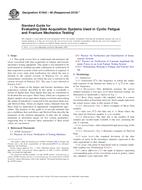We need your consent to use the individual data so that you can see information about your interests, among other things. Click "OK" to give your consent.
ASTM E1942-98(2010)e1
Standard Guide for Evaluating Data Acquisition Systems Used in Cyclic Fatigue and Fracture Mechanics Testing (Includes all amendments And changes 8/14/2018).
Automatically translated name:
Standard Guide for Evaluating Data Acquisition Systems Used in Cyclic Fatigue and Fracture Mechanics Testing
STANDARD published on 1.11.2010
The information about the standard:
Designation standards: ASTM E1942-98(2010)e1
Note: WITHDRAWN
Publication date standards: 1.11.2010
SKU: NS-43673
The number of pages: 12
Approximate weight : 36 g (0.08 lbs)
Country: American technical standard
Category: Technical standards ASTM
The category - similar standards:
Annotation of standard text ASTM E1942-98(2010)e1 :
Keywords:
bandwidth, data acquisition, data rate, data skew, drift, fatigue, filter, fracture mechanics, noise, phase shift, quantization, sample rate, signal conditioning, step response, ICS Number Code 19.060 (Mechanical testing)
Additional information
| 1. Scope | ||||||||
|
1.1 This guide covers how to understand and minimize the errors associated with data acquisition in fatigue and fracture mechanics testing equipment. This guide is not intended to be used instead of certified traceable calibration or verification of data acquisition systems when such certification is required. It does not cover static load verification, for which the user is referred to the current revision of Practices E 4, or static extensometer verification, for which the user is referred to the current revision of Practice E 83. The user is also referred to Practice E 467. 1.2 The output of the fatigue and fracture mechanics data acquisition systems described in this guide is essentially a stream of digital data. Such digital data may be considered to be divided into two types- Basic Data, which are a sequence of digital samples of an equivalent analog waveform representing the output of transducers connected to the specimen under test, and Derived Data, which are digital values obtained from the Basic Data by application of appropriate computational algorithms. The purpose of this guide is to provide methods that give confidence that such Basic and Derived Data describe the properties of the material adequately. It does this by setting minimum or maximum targets for key system parameters, suggesting how to measure these parameters if their actual values are not known. |
||||||||
| 2. Referenced Documents | ||||||||
|
We recommend:
Updating of laws
Do you want to be sure about the validity of used regulations?
We offer you a solution so that you could use valid and updated legislative regulations.
Would you like to get more information? Look at this page.




 Cookies
Cookies
